IS SHAOLIN KUNGFU TOO FLOWERY FOR COMBAT?
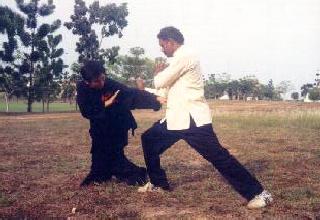
|
|
|

|
|
|
Many people, including kungfu students, have the mis-conception that Shaolin Kungfu is too flowery -- meant for demonstration but not capable for combat. Have a look at some Shaolin kungfu patterns, such as those illustrated on the right and below. "How can we use them for combat?" many people may ask. "What we need for fighting," they may reason, "are just some powerful punches and kicks, and some blocks to defend against these attacks."
The suspicion that kungfu cannot be used for fighting is aggrevated by the fact that an overwhelming majority of people who claim that they practise kungfu today, cannot really fight. Actually what these people practise is not genuine kungfu, but a demonstrative kungfu form called by past masters as "flowery fists and embroidery kicks". Real kungfu, including Taijiquan, must be capable of being applied for combat; otherwise it cannot be called kungfu.
In fact, Shaolin Kungfu, like the other two Shaolin treasures of Chi Kung and Zen, is simple, direct and effective. But looking at these five Shaolin kungfu patterns, some people may consider them complex, reserving the term "simple" for straight-forward blocks, kicks and punches.
From the Shaolin perspective, that would be simplistic or shallow, not simple. By simple, it is meant that the patterns are trimmed off all their frills, leaving only the essential movements necessary to acheive the purposes for which the patterns are designed. Hence, if you shift about or shout unnecessarily when executing a kick, this kicking pattern would be extraneous, although the kick itself may be simplistic or shallow. In a Shaolin pattern, not a single movement is wasted.

|

|
|
|
|
Why is it that Shaolin kungfu patterns are not simplistic like straight-forward blocks, punches and kicks, if the Shaolin approach is simple, direct and effective? This is because simplistic patterns are only useful when the combat situations are simplistic or when the combatants are shallow in their fighting techniques. When the situations have become complex, or when the combatants have gone beyond straight-forward punches and kicks, more elaborated patterns are preferred. The uninitiated mistakenly think that these patterns are flowery.
Let us examine how the five Shaolin patterns shown here are superior to straight-forward punches and kicks. These five patterns are each taken from the famous Shaolin Five Animals -- dragon, snake, tiger, leopard and crane -- which are figurative representations of five different major approaches in defence and attack, as well as in training for personal development.

|
|
|
This classification into five major appraoches for combat and for personal development is itself a clear indication of Shaolin's superiority over martial arts which use the same appraoch irrespective of who the opponents or what the situations are, and which seldom go beyond training for fighting.
Most martial arts use solely the leopard approach, which focuses on speed and power. Hence such martial artists have little or no appreciation of energy flow or internal force, because the snake and the tiger approaches that develop these qualities, are not found in their training.
It is significant to note that these qualities of speed and power from the leopard, energy flow from the snake, internal force from the tiger, as well as elegance from the crane, and intuitive awareness from the dragon, are trained in Shaolin Kungfu not merely for fighting but perhaps more importantly for enriching our daily work and play. In combat application, Shaolin kungfu is not only simple, direct and effective, it is also elegant and artistically beautiful.

|
|
|
To the uninitiated, the dragon pattern known as "Double Dragons Carrying Pearl" shown in the photo above, may appear like a decorative art form, but is actually a deadly technique that may kill in just one move.
The photos below demonstrated by my disciple Mogan and me, show an application of "Double Dragons Carrying Pearl" for combat. As soon as I deflect Mogan's attack, I move my right hand towards his chin, and my left hand towards the back of his head. Simultaneously I move forward, and with a twist I can dislodge the opponent's head, thus killing him. But Shaolin disciples are trained to be compassionate; hence I would just hold the opponent's head under control.
It is obvious that this "Double Dragons Carrying Pearl" pattern, which puts the opponent off-balanced and in an apparently helpless position with just one smooth action, is superior to straight-forward punches and kicks. If you are willing to train only for this pattern for three years, you would become so skilful in its application that you could put an opponent in an awkward position as soon as he attacks you.
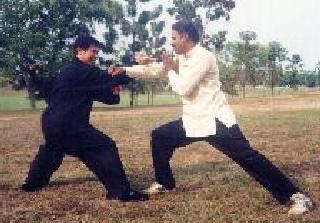
|
|
|
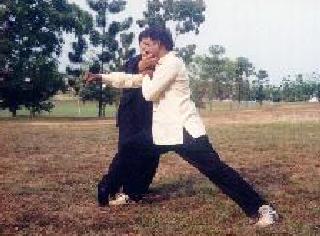
|
|
|

|
|
|
Some martial arts use only the clenched fists in their hand attacks, thinking that the fingers and the palms are less powerful. From the Shaolin perspective, this attitude is due to shallow understanding. The fingers and the palms are generally more deadly than the fists, and are more suitable when attacks are directed to certain parts of the body or for particular situations. The series of three photos below illustrate the finger strike in the snake pattern "Poisonous Snake Basking in Mist".
After blocking my left hand attack, Mogan follows up immediately with a palm strike to my temple or neck. Without moving my feet, I shift my body slightly backward, and simultaneously "cover" the strike with a circular movement of my left hand. Continuing the circular movement like a wriggling snake and generating both the movement and the internal force from my waist to my fingers, I slice Mogan's eyes with the finger tips.
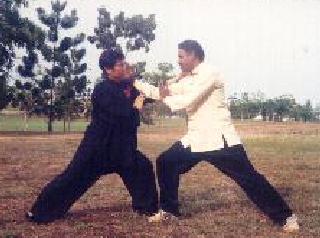
|
|
|
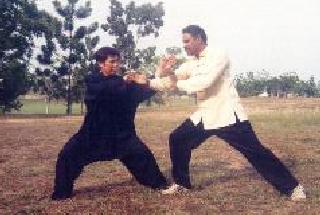
|
|
|

|
|
|
In reality, of course, I only stroke his eyebrows -- even if he is a real opponent in a fight. A Shaolin disciple never unnecessarily maims his opponent. By stroking his eyebrows instead of slicing his eyes, you could not only avoid causing suffering to others, but may also convert an enemy into a friend.
The techniques described here and the remaining part of this document are fairly advanced. They are chosen as examples to illustrate that although they may look flowery or decorative to the uninitiated, these techniques are actually simple, direct and effective for combat. Students will get more benefits if they first spend some time over straight-forward techniques before progressing to these comparatively advanced ones.Although these techniques are advanced, it should not be imagined that they are unbeatable. Every technique, no matter how complex or difficult it is, can be overcome. In a subsequent webpage, we shall examine how the techniques described here and the second part of this document can be countered.

|
|
|
One should also realize that in combat what are often more important than techniques are force and skills. In other words, if you just know the techniques but do not have sufficient force or the necessary skills, such as correct timing and spacing and fluidity of movement, you will be unable to implement the techniques even if you know them theoretically.
Learning the fine points of techniques is difficult enough; learning skills from a webpage, a book or a video is virtually impractical. Skills have to be acquired under the supervision of a master or at least a competent instructor, and we have to practise and practise consistently for the acquired skills to be lasting.
Many people looking at the tiger pattern "Two Tigers Subdue Dragon" illustrated on the left, may think that it is merely flowery or decorative. They would be surprised to know that this Shaolin kungfu pattern is a very effective technique to counter kicks, especially side-kicks.
Indeed, years ago when I used to spar frequently with martial artists of various styles, this "Two Tigers Subdue Dragon" had almost never failed to help me overcoming side-kicks. If you are skilfully trained in this Shaolin kungfu pattern, an opponent executing a side-kick at you is like kicking into a trap.
The photos below illustrate how this "Two Tigers Subdue Dragon" may be applied. As Mogan kicks at me, I shift my body backwards, without moving my feet, to neutralize the direct force of the kick, simultaneously setting up a trap with my two "tigers".
The two "tigers" trap the kicking leg at its full extent. Even if I fail to trap the foot or the opponent may continue kicking many times very fast, the kicking leg cannot hit me because I have moved the target, which in this case is my body, away from its kicking range.
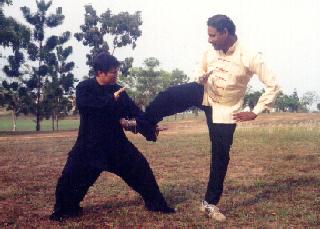
|
|
|
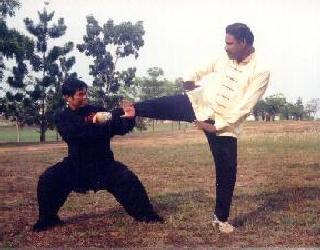
|
|
|
There are numerous ways I can follow up from my advantageous position. I may, for example, grip at the vital points of the foot, twist the ankle to dislocate the foot from the leg, or move in still with the opponent's foot in my trap and kick at his knee or groin with my toes. But being compassionate, a Shaolin disciple often just pulls forward or pushes backward sharply to let the opponent fall.

|
|
|
"Golden Leopard Turning Around" is fast and powerful as well as beautiful to watch. In this Shaolin kungfu pattern I use the "leopard punch", formed by bending the first knuckles, instead of the normal clenched fist because it is a more suitable hand-form for striking the ribs as it is used here.
In the first photo below, Mogan deftly deflects my thrust punch with a monkey-paw. The monkey mode of combat is well known for using minimum force against maximum strength. Although Mogan is bigger sized and stronger than me, and is capable of employing a powerful block, he does not have to waste strength when minimum effort is sufficient as in the case of the monkey-paw technique here.
Moreover. this monkey-paw is more suitable for his follow-up dragon-palm strike at my ribs. Had Mogan used a powerful block as often is the case in some other martial arts, he would not only expend unnecessarily energy, he would have to pull back his arm before he could strike again. In the case of this monkey-paw, he can execute both the defence and the counter-attack in one smooth movement.
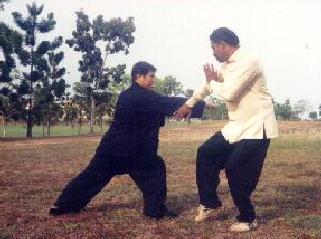
|
|
|
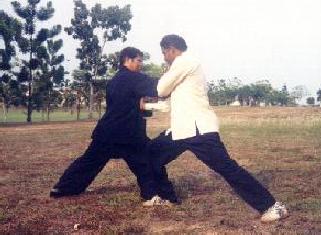
|
|
|

|
|
|
Notice that Mogan guards my attacking arm with his other hand as he strikes at my ribs. Instead of blocking or moving away, I just turn around into a unicorm-stance using the pattern "Golden Leopard Turning Around" and strike Mogan's ribs with a leopard punch almost at the same time when his dragon-palm strike is spent, and often without the opponent realizing where does the counter-strike come from!
One can't help admiring the beauty of this Shaolin pattern -- it is beautiful not merely as an elegant, powerful and artisitc movement, but in its technical and tactical considerations which are so profound although the pattern is actually simple.

|
|
|
The form that is best known for elegance is the crane. The Shaolin crane pattern shown on the right is known as "Single-Legged Hungry Crane". Again, uninitiated martial artists, including those who have practised Shaolin Kungfu for many years but without understanding its combative meaning, may think that this crane pattern is merely an artistic decoration. "What are the two crane-beaks doing there, and why is the exponent standing on one leg?" they often wonder. The photos below illustrate the combat function of this crane pattern.
As Mogan attacks me with his left hand, I move back into the false-leg stance and hook his attacking arm at his elbow with my left crane-beak. It is not necessary to use strength to hook the attack because I already have moved away from the attack by shifting backward into the false-leg stance. The purpose of the crane-beak hook is to keep his arm under control as well as to distract him.
Immediately I use my other crane-beak to strike his eye or temple. This is a feign attack if he attempts to defend against it, but real if he fails to defend. As soon as he reacts to this attack, he finds my "organ-seeking leg" kicking at his sex organs.
Of course, in line with the Shaolin teaching, I would only beck at his forehead or merely touch his organ. Maim his eye or explode his organ, and you will have an enemy for life; spare him and you will win a friend -- even for the few minutes when he shows gratitude.
Shaolin disciples are also aware that spared opponents may fight back immediately or come back later to take revenge -- some people, unfortunately, still return kindness with vengence. One should also bear in mind that he (or she) must be ready for any surprised counter-attack from the opponent even if the opponent is in an apparently helpless position. A subsequent webpage will illustrate how the opponent can overcome the apparently helpless positions shown here.
There are two extreme attitudes in martial art circles (and also in political and business circles in modern societies) regarding one's opponents. One is "to cut grass by removing the roots", and the other is "to treat your opponents like your friends". The first attitude is barbaric, often inhuman, including killing innocent children of the opponents. The second attitude is what Shaolin disciples adopt.
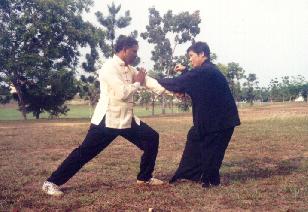
|
|
|

|
|
|
This Shaolin attitude is not totally altruistic; some self-interest is involved, although the self-interest is not selfish in the normal sense of the word. A genuine Shaolin disciple practises kungfu, including its application in real combat, as a part of his (or her) spiritual cultivation. It would be very unwise of him to soil his years of spiritual development in a moment of malice or vengence.
If you have any suggestions or questions, please e-mail to secretary@shaolin.org stating your name and country.
You can view a selection of Sifu Wong's answers to readers' questions at QUESTIONS-ANSWERS.
